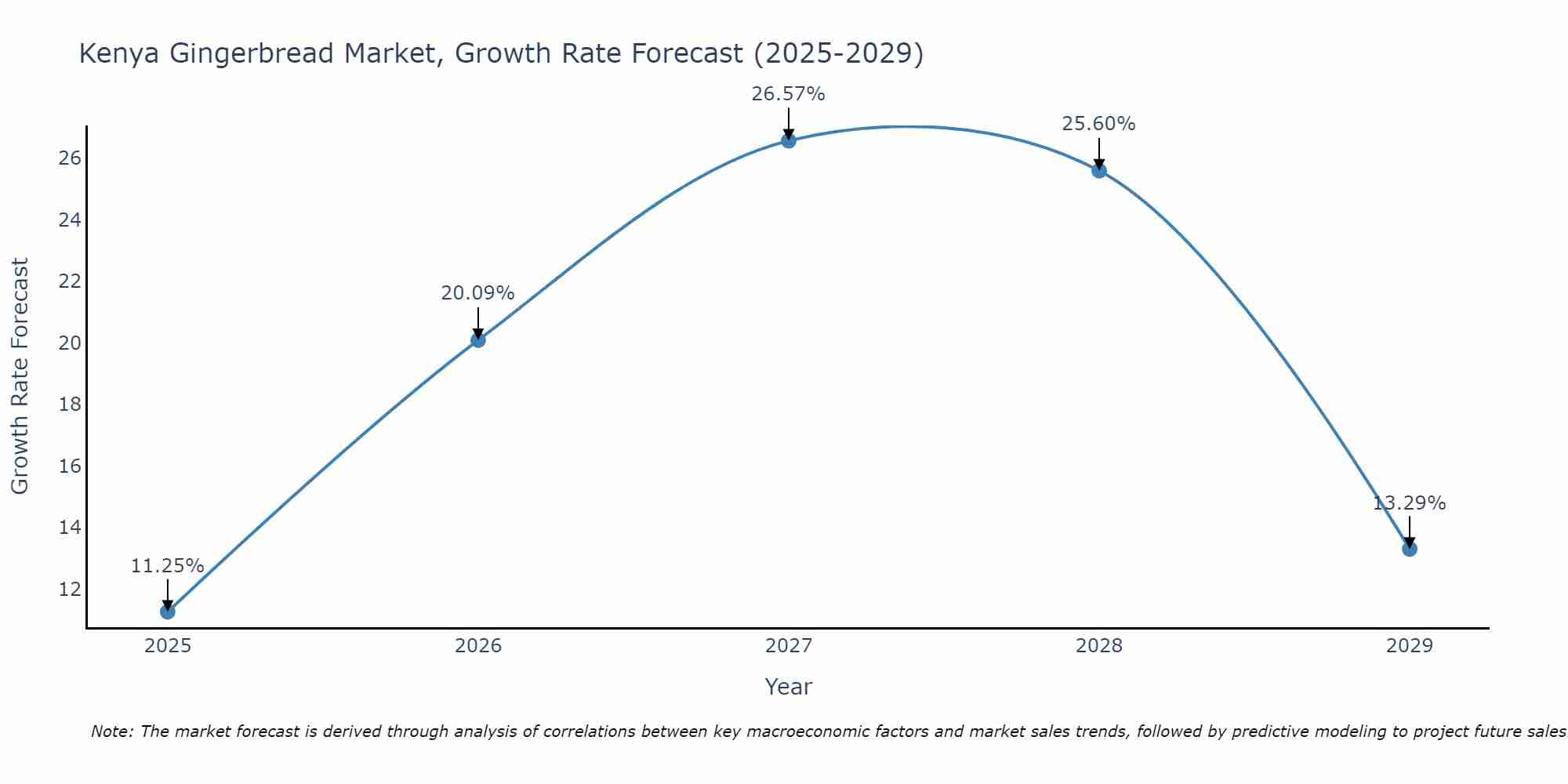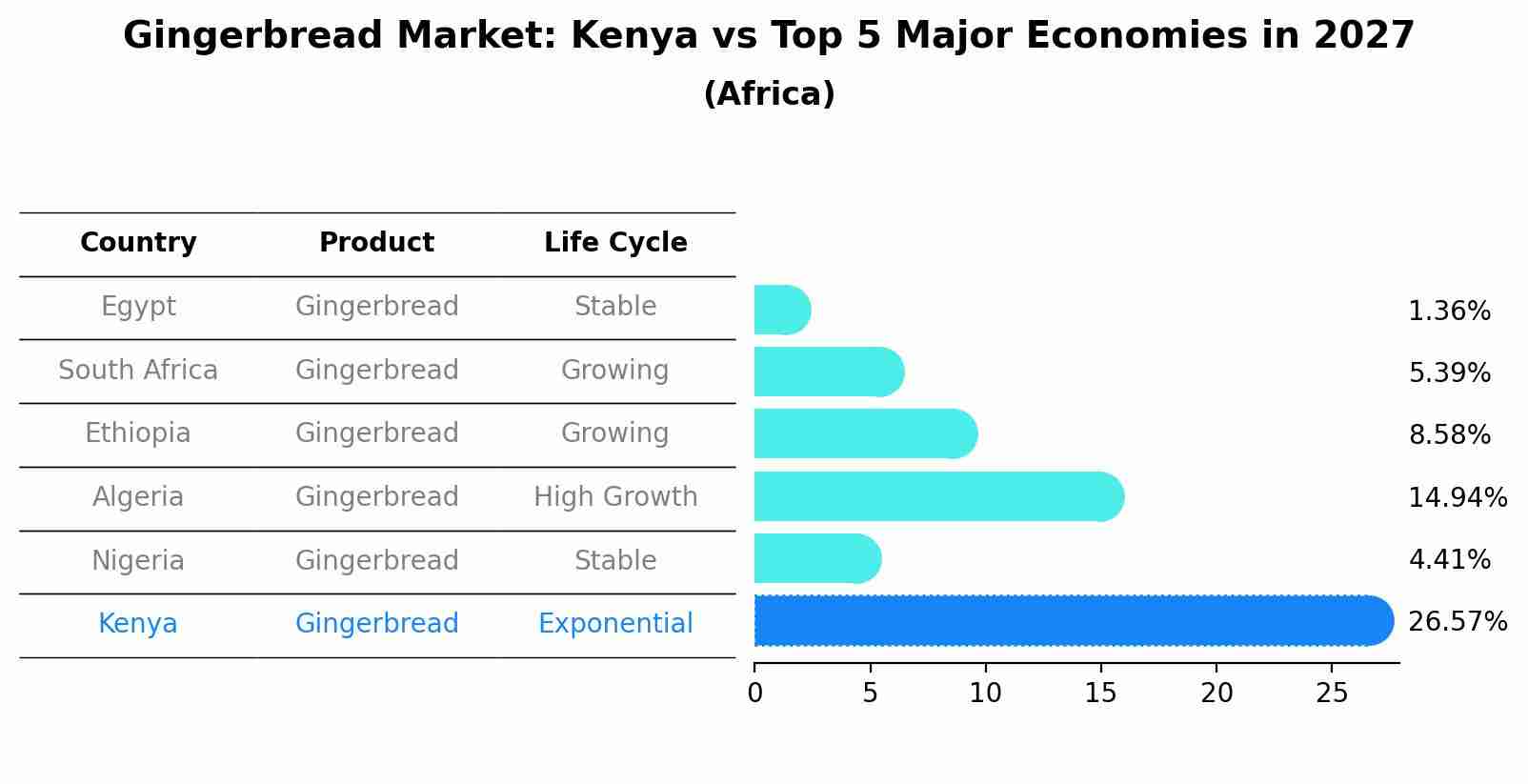Kenya Gingerbread Market Outlook | Value, Companies, Size, Revenue, Analysis, Forecast, Growth, COVID-19 IMPACT, Trends, Industry & Share
| Product Code: ETC410866 | Publication Date: Oct 2022 | Updated Date: Jul 2025 | Product Type: Market Research Report | |
| Publisher: 6Wresearch | Author: Sachin Kumar Rai | No. of Pages: 75 | No. of Figures: 35 | No. of Tables: 20 |
Kenya Gingerbread Market Size Growth Rate
The Kenya Gingerbread Market is projected to witness mixed growth rate patterns during 2025 to 2029. Starting at 11.25% in 2025, the market peaks at 26.57% in 2027, and settles at 13.29% by 2029.

Gingerbread Market: Kenya vs Top 5 Major Economies in 2027 (Africa)
Kenya's Gingerbread market is anticipated to experience a exponential growth rate of 26.57% by 2027, reflecting trends observed in the largest economy Egypt, followed by South Africa, Ethiopia, Algeria and Nigeria.

Kenya Gingerbread Market Synopsis
The Kenya gingerbread market is experiencing steady growth driven by increasing consumer preference for healthy and flavorful bakery products. Gingerbread, a traditional spiced biscuit or cake made with ginger, molasses, and other spices, has gained popularity in Kenya due to its unique taste and health benefits. The market is characterized by a variety of gingerbread products available in different shapes, sizes, and flavors, catering to diverse consumer preferences. Local bakeries and confectionery companies are expanding their product offerings to include gingerbread, leveraging its growing demand. Additionally, the rising trend of health-conscious consumption and the incorporation of traditional flavors in modern baked goods are further fueling the market growth. With a focus on quality ingredients and innovative packaging, the Kenya gingerbread market is poised for continued expansion in the coming years.
Kenya Gingerbread Market Trends
In Kenya, the gingerbread market is experiencing a growing trend towards healthier and premium options. Consumers are increasingly looking for gingerbread products made with natural and organic ingredients, free from artificial additives and preservatives. There is also a rising demand for gingerbread products that cater to specific dietary requirements, such as gluten-free or vegan options. Additionally, artisanal and gourmet gingerbread products are gaining popularity among urban consumers who are willing to pay a premium for high-quality, unique flavors and innovative packaging. The market is witnessing a shift towards more creative and diverse flavor profiles, incorporating local Kenyan ingredients and traditional spices to appeal to a wider audience. Overall, the Kenya gingerbread market is evolving to meet the changing preferences and demands of health-conscious and adventurous consumers.
Kenya Gingerbread Market Challenges
In the Kenya gingerbread market, several challenges are faced, including inconsistent supply of quality ginger, high production costs due to fluctuating prices of raw materials, limited awareness and demand for gingerbread products among consumers, and stiff competition from other baked goods. Additionally, issues such as lack of proper infrastructure for storage and transportation, as well as difficulties in accessing financing for small-scale producers, hinder the growth of the gingerbread market in Kenya. Overcoming these challenges would require efforts to improve the quality and consistency of ginger supply, raise awareness about gingerbread products, develop cost-effective production techniques, and provide support for market access and financing opportunities for producers in the industry.
Kenya Gingerbread Market Investment Opportunities
The Kenya gingerbread market presents promising investment opportunities due to the increasing consumer demand for unique and flavorful baked goods. Investors can explore opportunities in establishing gingerbread bakeries, supplying gingerbread products to cafes and restaurants, or developing gingerbread mixes for retail distribution. With the rising trend of health-conscious consumers seeking natural ingredients like ginger, there is potential for premium and organic gingerbread products to capture a niche market segment. Additionally, leveraging Kenya`s abundant supply of ginger can provide a competitive advantage in terms of sourcing raw materials locally. Investing in marketing strategies to promote gingerbread as a versatile snack or dessert option can also help attract a wider customer base and drive growth in this market segment.
Jordan Agar Market Government Policies
Government policies related to the Kenya Gingerbread Market focus on promoting agricultural production, supporting small-scale farmers, and ensuring food safety standards. The government provides subsidies and incentives to ginger farmers to encourage production and improve yields. Additionally, there are regulations in place to ensure that gingerbread products meet quality and safety standards. The government also supports initiatives to promote value addition and export of ginger products to increase market opportunities for producers. Overall, the government aims to boost the gingerbread market by creating a favorable environment for farmers and businesses, while also safeguarding consumer health and promoting economic growth in the agricultural sector.
Kenya Gingerbread Market Future Outlook
The Kenya gingerbread market is expected to experience steady growth in the coming years. Factors such as increasing consumer awareness about the health benefits of ginger, rising disposable incomes, and a growing interest in gluten-free and natural products are driving the demand for gingerbread in Kenya. Additionally, the trend of incorporating traditional ingredients into modern recipes and the popularity of gingerbread as a snack or dessert option are expected to further boost market growth. With a focus on product innovation, packaging, and marketing strategies tailored to the preferences of Kenyan consumers, the gingerbread market in Kenya is poised for expansion and offers opportunities for both local producers and international brands looking to tap into this growing segment.
Key Highlights of the Report:
- Kenya Gingerbread Market Outlook
- Market Size of Kenya Gingerbread Market, 2021
- Forecast of Kenya Gingerbread Market, 2031
- Historical Data and Forecast of Kenya Gingerbread Revenues & Volume for the Period 2018 - 2031
- Kenya Gingerbread Market Trend Evolution
- Kenya Gingerbread Market Drivers and Challenges
- Kenya Gingerbread Price Trends
- Kenya Gingerbread Porter's Five Forces
- Kenya Gingerbread Industry Life Cycle
- Historical Data and Forecast of Kenya Gingerbread Market Revenues & Volume By Application for the Period 2018 - 2031
- Historical Data and Forecast of Kenya Gingerbread Market Revenues & Volume By Household for the Period 2018 - 2031
- Historical Data and Forecast of Kenya Gingerbread Market Revenues & Volume By Commercial for the Period 2018 - 2031
- Historical Data and Forecast of Kenya Gingerbread Market Revenues & Volume By Distribution Channel for the Period 2018 - 2031
- Historical Data and Forecast of Kenya Gingerbread Market Revenues & Volume By Online for the Period 2018 - 2031
- Historical Data and Forecast of Kenya Gingerbread Market Revenues & Volume By Offline for the Period 2018 - 2031
- Kenya Gingerbread Import Export Trade Statistics
- Market Opportunity Assessment By Application
- Market Opportunity Assessment By Distribution Channel
- Kenya Gingerbread Top Companies Market Share
- Kenya Gingerbread Competitive Benchmarking By Technical and Operational Parameters
- Kenya Gingerbread Company Profiles
- Kenya Gingerbread Key Strategic Recommendations
Frequently Asked Questions About the Market Study (FAQs):
- Single User License$ 1,995
- Department License$ 2,400
- Site License$ 3,120
- Global License$ 3,795
Search
Thought Leadership and Analyst Meet
Our Clients
Related Reports
- Canada Oil and Gas Market (2026-2032) | Share, Segmentation, Value, Industry, Trends, Forecast, Analysis, Size & Revenue, Growth, Competitive Landscape, Outlook, Companies
- Germany Breakfast Food Market (2026-2032) | Industry, Share, Growth, Size, Companies, Value, Analysis, Revenue, Trends, Forecast & Outlook
- Australia Briquette Market (2025-2031) | Growth, Size, Revenue, Forecast, Analysis, Trends, Value, Share, Industry & Companies
- Vietnam System Integrator Market (2025-2031) | Size, Companies, Analysis, Industry, Value, Forecast, Growth, Trends, Revenue & Share
- ASEAN and Thailand Brain Health Supplements Market (2025-2031) | Strategy, Consumer Insights, Analysis, Investment Trends, Opportunities, Growth, Size, Share, Industry, Revenue, Segments, Value, Segmentation, Supply, Forecast, Restraints, Outlook, Competition, Drivers, Trends, Demand, Pricing Analysis, Competitive, Strategic Insights, Companies, Challenges
- ASEAN Bearings Market (2025-2031) | Strategy, Consumer Insights, Analysis, Investment Trends, Opportunities, Growth, Size, Share, Industry, Revenue, Segments, Value, Segmentation, Supply, Forecast, Restraints, Outlook, Competition, Drivers, Trends, Demand, Pricing Analysis, Competitive, Strategic Insights, Companies, Challenges
- Europe Flooring Market (2025-2031) | Outlook, Share, Industry, Trends, Forecast, Companies, Revenue, Size, Analysis, Growth & Value
- Saudi Arabia Manlift Market (2025-2031) | Outlook, Size, Growth, Trends, Companies, Industry, Revenue, Value, Share, Forecast & Analysis
- Uganda Excavator, Crane, and Wheel Loaders Market (2025-2031) | Strategy, Consumer Insights, Analysis, Investment Trends, Opportunities, Growth, Size, Share, Industry, Revenue, Segments, Value, Segmentation, Supply, Forecast, Restraints, Outlook, Competition, Drivers, Trends, Demand, Pricing Analysis, Competitive, Strategic Insights, Companies, Challenges
- Rwanda Excavator, Crane, and Wheel Loaders Market (2025-2031) | Strategy, Consumer Insights, Analysis, Investment Trends, Opportunities, Growth, Size, Share, Industry, Revenue, Segments, Value, Segmentation, Supply, Forecast, Restraints, Outlook, Competition, Drivers, Trends, Demand, Pricing Analysis, Competitive, Strategic Insights, Companies, Challenges
Industry Events and Analyst Meet
Whitepaper
- Middle East & Africa Commercial Security Market Click here to view more.
- Middle East & Africa Fire Safety Systems & Equipment Market Click here to view more.
- GCC Drone Market Click here to view more.
- Middle East Lighting Fixture Market Click here to view more.
- GCC Physical & Perimeter Security Market Click here to view more.
6WResearch In News
- Doha a strategic location for EV manufacturing hub: IPA Qatar
- Demand for luxury TVs surging in the GCC, says Samsung
- Empowering Growth: The Thriving Journey of Bangladesh’s Cable Industry
- Demand for luxury TVs surging in the GCC, says Samsung
- Video call with a traditional healer? Once unthinkable, it’s now common in South Africa
- Intelligent Buildings To Smooth GCC’s Path To Net Zero


















